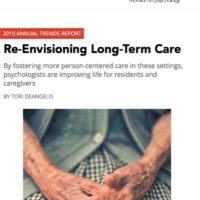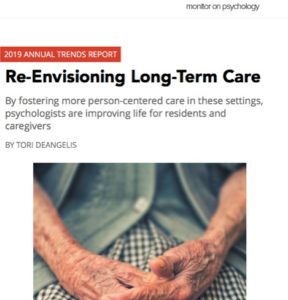Blog

McKnight’s Online Expo, FREE, March 27th and 28th 2019
McKnight’s Online Expo, FREE, March 27th and 28th 2019
Once again, McKnight’s will host its annual online expo, which is a chance to attend a conference without leaving your desk.
Register for the conference in advance, and then log in to hear the talks, visit the vendors, and chat with the reps and attendees.
This year’s topics are:
- PAYMENT: Operational strategies for surviving the regulatory, payment and other changes ahead
- WOUND CARE: Understanding wounds at end-of-life
- TECHNOLOGY: Mobile tech: Friend or foe in the LTC workplace?
- QUALITY: Understanding the practical implications of trauma-informed care
- CAPITAL: Finding capital in 2019
To register, go to: www.mcknights.com/Expo2019

How to quit like a shrink
Here’s my latest article on McKnight’s Long-Term Care News:
How to quit like a shrink
Employees leave their positions for many reasons — organizational restructuring, family needs, a better offer — and they exit their jobs in a variety of different ways. Some sneak out quietly so that their coworkers find out only after they’re already gone. Others have a swift, drama-filled exit, walking off after an argument, never to return.
While we as individuals may have no say over how our companies discharge workers, if we’re voluntarily leaving an organization, we’re likely to have a significant amount of control over how we depart. For professionals hoping to maintain connections with colleagues, leave-taking is an opportunity to create a positive last impression. While we’re making the effort to finish up our work and create a smooth handoff of responsibilities, we also can showcase our expertise in handling exits.
As I noted in a column about how to fire staff members, “The Good-bye Guide: Why and how to terminate tenderly in LTC,” endings of all kinds are especially important in this field. Beloved residents may die unexpectedly or be transferred to the hospital and vanish from our lives. With the departure of each resident, their families disappear as well, compounding the loss.
This steady but generally unacknowledged drumbeat of sadness has a strong impact on workers. (I believe it’s why many employees don’t complete their first year. For more on that topic, see “Absenteeism and turnover in LTC? Death anxiety could be the cause”.) In an environment where there are many sudden and sometimes disturbing endings, well-planned departures can be opportunities to heal some of this pain.
They also can help to solidify connections and offer an opening to obtain contact information for colleagues with whom you’d like to stay in touch after you’ve gone.
There are entire volumes devoted to the psychological process of termination, but I’ve created a quick guide below based on my experiences with leave-taking in LTC:
- Give people time to emotionally and practically process your departure. Typically, this is two to four weeks, depending on the level of your interactions with them.
For the entire article, visit:
How to quit like a shrink


Sleep deprivation and pain
Here’s my latest article on McKnight’s Long-Term Care News:
Sleep deprivation and pain
Despite the fact that my search for column inspiration took place at 3 a.m., I chose the topic of sleep deprivation because residents regularly tell me about their own sleep disturbances. They also discuss their pain.
Though their aches often keep them up at night, a January 2019 article in the New York Times, “Why It Hurts to Lose Sleep,” suggests that there’s a more complicated relationship between sleep and pain.
Author Benedict Carey described research finding “that a single night of sleep deprivation reduced a person’s pain threshold by more than 15 percent.” In addition, “small deviations in the average amount of sleep from one day to another predicted the level of overall pain felt the next day.” Staying up all night — which has been known to happen in the long-term care setting — increased pain sensitivity by 15% to 30%.
This interaction between sleep and physical discomfort is particularly relevant to those of us working in eldercare. Increased use of pain medications not only raises pharmacy costs, but can lead to a host of other problems, including constipation, daytime drowsiness, increased fall risk, the possibility of addiction, medication interactions, breathing problems and more. Each of these complications can, in turn, lead to further difficulties.
Perhaps the silver lining in these significant complications will be that more attention is paid to sleep disturbances in long-term care.
I suspect that the shift-based nature of nursing care makes it easier to discount this issue. If an elder with disrupted sleep were at home keeping their caregivers awake, it would be a major problem for the family. In the nursing home, the nighttime care providers are already up, the daytime workers arrive to work rested and the administrative staff members aren’t around to directly observe the effects of unsettled sleep. It’s the residents who must contend with the mid-night disruptions of their peers.
One loud, agitated resident can awaken most of his or her neighbors. If, as this research suggests, all of those people feel discomfort more intently the next day, this could increase their requests for pain medications. Their fatigue might reduce their progress in rehab and increase their likelihood of irritability. This outbreak of insomnia, pain and aggravation should be attended to as much as scabies or lice.
For the entire article, visit:
Sleep deprivation and pain


Self-care, team-care and an empty well
Here’s my latest article on McKnight’s Long-Term Care News:
Self-care, team-care and an empty well
“How’s it going?” I asked Larry, one of the maintenance workers I chatted with from time to time. He didn’t have his usual smile and his wrist was in a brace from a repetitive stress injury.
“I’m tired,” he replied. “I’m real tired. I was supposed to be off today but Jules called in sick and we were already short one guy. Tomorrow will make seven days of work in a row.”
“You’ve got to take care of yourself,” I encouraged him.
“I know,” he said, “but they needed me.”
A few months after my encounter with Larry, I noticed that an excellent nurse had “lost her shine.” I stopped by her med cart to see why.
“My sister’s very sick,” Shirley told me, becoming tearful. “She lives in Haiti and I’m worried about her.”
“Oh no! Do you have any vacation time? Can you go see her?”
“I do, but I don’t know if the director of nursing will sign off on it. I guess I could try.”
I followed up with her the next week as if she’d been one of my patients.
“No,” Shirley said as I approached the nursing station, “I didn’t put in for the vacation time.”
She’d lost weight since the prior week and her expression had become grim. I regularly observed her completing paperwork and tending to the residents an hour after her shift was over.
“Let’s do it now,” I insisted. I stood at the desk while Shirley filled in the form requesting time off the following month. That weekend she had a heart attack.
I’ve met many Larrys and Shirleys over the years. If asked, they’ll work the extra shift because they’re the type of people who don’t like to say no. While it’s tempting for organizations to meet staffing needs with someone who always says yes, good managers recognize that such requests can push employees to the brink. Encouraging employees to engage in ongoing self-care and to recognize when they need to “refill the well” can reduce their chances of burnout and illness, leading to better workers, improved care and fewer missed shifts overall.
Self-care for healthcare workers is, according to one research paper, “a proactive and holistic approach to promoting personal health and well-being to support professional care of others.” Team-care — a concept I learned while researching this article — refers to coworkers supporting and encouraging the self-care efforts of their teammates.
When I asked after the well-being of Larry and Shirley, I was engaging in team-care. While I often informally check in with my coworkers, team-care is much more effective if it’s a consistent, leader-supported element of workplace culture.
There are many ways in which individuals can engage in self-care and be supported by facilities and coworkers in their efforts.
Self-care, team-care and an empty well


Severely mentally ill residents: A ‘perfect storm’ creates a SNF wave
Here’s my latest article on McKnight’s Long-Term Care News:
Severely mentally ill residents: A ‘perfect storm’ creates a SNF wave
Long-term care facilities are admitting more residents with longstanding psychiatric illnesses. Such individuals enter the nursing home for physical rehabilitation but are difficult to discharge back to the community due to their mental health needs, weak or nonexistent support networks and unstable prior housing situations.
This column focuses on why the severely mentally ill (SMI) population is increasing, and the impacts of this change and on strategies to manage care.
A mounting possibility
I predict we’ll be seeing greater numbers of SMI residents due to the combination of factors outlined below.
The movement toward deinstitutionalization in the 1970s and 1980s closed many psychiatric facilities without increasing community assistance. Because of the lack of community resources, parents of children with severe mental illness frequently became their lifelong supports.
Many SMI people are now over 50 years old; their caregiver parents are in their seventies and eighties. Older parents are less able to provide financial, practical and emotional aid for their adult children due to their own aging and health problems.
In addition, as adults with SMI get older themselves, they’re increasingly likely to experience medical problems requiring hospitalization and rehab, which brings them to our doors.
To estimate the numbers of older SMI individuals, I looked at statistics on mental illness and aging. According to the National Institute of Mental Health (NIMH), 2.7% of US adults aged 50 and older were diagnosed with SMI in 2016. In 2014, AARPnotes that there were 108.7 million people aged 50 and over in the US. Combining these statistics gives us a rough estimate of almost 3 million SMI adults over age 50 in the US, with the number increasing as the baby boomers age.
I looked at the statistics on LTCfocus.orgto ascertain whether this trend toward increasing numbers of people with SMI in LTC is beginning. The data show the numbers of residents diagnosed with schizophrenia and bipolar disorder between the years of 2000 and 2016. In my state, New York, 6.45% of residents had those diagnoses in 2000; in 2016 it was 11.8%. In Pennsylvania, the numbers increased during that time period from 4.45% to 9.3%. California: 8.87% to 15%. Texas: 4.91% to 13.4%.
The pattern is clear.
As a complicating factor, the US healthcare system has distinguished between treatment for physical health and mental health. There are very few institutional or community resources that are able to care for people with both physical and mental health impairments. There is virtually nowhere to discharge residents without family support who need assistance for comorbid medical disorders and severe mental illness.
Thus we have a perfect storm of treatment failures for our aging severely mental ill population and one that’s likely become more critical as the number of aging SMI individuals increases due to demographic shifts.
Severely mentally ill residents: A ‘perfect storm’ creates a SNF wave


A gift from LTC families
Here’s my latest article on McKnight’s Long-Term Care News:
A gift from LTC families
A study of interactions between families and healthcare providers published in the BMJ this month sparked my interest. It showed that improving communication between the two groups reduced harmful medical errors by 39%.
As if that vast reduction in medical errors weren’t enough, it was caused by harnessing the input of team members who don’t cost facilities a penny. In an era of intense financial pressures for the industry, free team members are a gift that shouldn’t be overlooked.
According to the researchers, the study “indicates that improving communication between families and healthcare providers doesn’t just feel good, it can help improve the safety and quality of care.”
Family strength
In Editor Jim Berklan’s excellent blog postlast month, he points out research that shows that families “don’t know what they’re talking about” when it comes to loved ones’ end-of-life care preferences. (If that’s so, we as experts should be facilitating Care Conversations.)
While family members may fall short on end-of-life wishes, they’re generally more expert than we are on their parents’ medical history and behavior. They know that their father didn’t react well to a particular medication when he took it at home or that Mom is “acting funny,” even if they don’t know why.
I myself have gone to the nursing station with the complaint that a resident is “off” somehow and been dismissed in my concerns, to the detriment of the resident’s health. Over the years, I’ve learned that I should phrase it as a “change in mental status” and to speak in a tone that conveys the depth of my experience and the seriousness of my observations, but basically I’m saying that the resident is “acting funny” and it seems physical, not psychological. I’ve detected sepsis, strokes and other emergencies this way.
If the nurses aren’t receptive to perhaps poorly-phrased information from psychologists, recreation therapists and other non-medical personnel, they may also be missing valuable information from families.
The BMJstudy shows how we can train staff to be more responsive to family input.
Family-centered rounds
For the entire article, visit:
A gift from LTC families


Healthcare changes that burn me out — and burn me up
Here’s my latest article on McKnight’s Long-Term Care News:
Healthcare changes that burn me out — and burn me up
I was recently required to take an online training module on burnout for physicians and allied professionals. It was the first time in 20-plus years that I’d received a formal message about self-care from any long-term care institution (aside from yearly staff appreciation barbecues and survey completion parties).
While I was impressed and grateful for the focus on caregiver well-being, a couple of points bothered me.
The questionnaire asked readers to select the phrase they most associated with provider burnout. There were options such as “workplace dissatisfaction” and “challenging patients.” I chose “changes in the healthcare system,” which triggered a pathway specific to that option.
I was guided through a series of vignettes discussing issues old-timers might have trouble with, such as adapting to the electronic medical record. Following the vignettes, helpful strategies were offered to manage stress.
Then came the part I found disturbing: The details of the “changes in the healthcare system” choice included “the emphasis on the healthcare experience of consumers” and “the shift from volume to value.” Let me explain why that irks me.
The experience of healthcare
Regarding consumer experience, most of my direct care team members and I have been very focused over the years on accommodating the needs of residents. It’s become more difficult, however, to maintain care quality and orderly surroundings in a healthcare environment where financial pressures have led to staff reductions and increased turnover amidst higher acuity residents.
Trying to deliver a decent customer experience without the necessary tools is part of the change in the healthcare system that induces my feelings of burnout — not the “new” attention to perceptions of consumers.
I’d be gratified to see a genuine, top-down focus on the healthcare experience of residents and their families — complete with Resident Experience Officers in every long-term care facility (sign me up!). Such an emphasis would realign resources with a mission of care that can stabilize staffing and sustain facilities over time.
Volume to value
“The shift from volume to value” stresses me in a different way.
Part of my role as a psychologist in the “volume” approach has been to aid residents in negotiating their illnesses and treatments.
If necessary, I could help them stop a lucrative but unwanted onslaught of painful medical interventions by fostering communication with their physicians and families.
For the entire article, visit:
Healthcare changes that burn me out — and burn me up


Trend #5: Re-Envisioning Long-Term Care
The American Psychological Association published an article in the APA Monitor on “Trends to Watch in 2019.” I was pleased to see that geropsychology was Trend #5. Read what my colleagues and I have to say in Tori DeAngelis’ piece on Re-Envisioning Long-Term Care.

A hopeful day at LeadingAge 2018
Here’s my latest article on McKnight’s Long-Term Care News:
A hopeful day at LeadingAge 2018
I headed to the 2018 LeadingAge convention last week looking for a fix of long-term care enthusiasm and that’s exactly what I got.
I met up with old colleagues, put faces to voices I’d spoken to for years and wandered through the expo hall catching snippets of conversations that might be exciting only to long-term care professionals.
PDPM
Armed with a large cup of black coffee, I attended an early morning seminar on the Patient-Directed Payment Model (PDPM), mostly so I’d know what everyone was freaking out about at work. “Are there any payment adjustments for residents with behavioral health problems?” I inquired of the speakers. “No,” came the reply.
Facilities will continue to have to manage residents with anxiety, substance abuse and other difficult and time-consuming behaviors without financial remuneration through PDPM. For those looking for immediate answers, consulting psychologists can be a good resource for staff training and local associations may be able to offer educational sessions on specific topics across facilities.
Team building
I participated in a session offered by Christopher Ridenhour, GFN entitled, “The Other Voice: Race, Class, Culture and the Other ‘Isms’ in Aging Services.”
“And you wonder why we have a staffing crisis,” he said, pointing out, for example, that attendees walking briskly through the conference hall without acknowledging one another were likely to be doing the same thing with their staff members back at home.
Ridenhour emphasized that all workers, regardless of their race, age or any other characteristic, want to be recognized and appreciated.
The session included practice exercises that highlighted commonalities between participants. I left with a new friend with whom I “LinkedIn” the next day. We were born in different countries, work in different LTC roles and have almost a decade between us, but given the directive to “tell each other your life story in thirty seconds,” we found the kind of common ground that any employer would want for their team members.
Montessori for staff
The theme of connection was echoed in a session offered by psychologist Cameron Camp, Ph.D., and his colleagues at the Center for Applied Research in Dementia on teaching Montessori techniques to staff members.
For the entire article, visit: A hopeful day at LeadingAge 2018


Relationships key to long-term care success
Here’s my latest article on McKnight’s Long-Term Care News:
Relationships key to long-term care success
Long-term care success is about steady, reliable relationships. That’s my takeaway after attending two recent conferences that echo my experiences in the field.
The first event delivered the results thus far of an ongoing program that won a coveted grant from the Center for Medicare & Medicaid Services’ Center for Innovation. The OPTIMISTIC project is an effort of Indiana University and local partners, including the University of Indianapolis Center for Aging and Community. OPTIMISTIC is an acronym for Optimizing Patient Transfers, Impacting Medical Quality, and Improving Symptoms: Transforming Institutional Care.
The model entails placing registered nurses in nursing facilities, as well as giving staff access to nurse practitioners. The nurses function as educational trainers and as resources for the team.
The consistent relationships with these nursing experts produced astounding results, including a 32.6% reduced relative risk of potentially avoidable hospitalizations and a net savings to Medicare of $3.4 million.
The second conference in which I participated was a National Readmission Collaborative event.
Keynote speaker Eric A. Coleman, M.D., discussed research on phone calls following up with patients after discharge from the hospital. While such contacts have been touted as an effective means of identifying and remedying precursors to hospital readmission, patients are often barraged with contacts from various service providers. These well-intentioned efforts thus become annoyances without real value to the patient and their family.
Having one consistent, informed care manager across the healthcare continuum proves more useful and effective, he reports.
As a psychologist, I’m not at all surprised.
For the entire article, visit:
Relationships key to long-term care success




